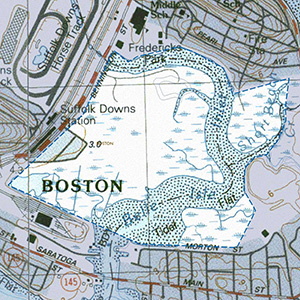Important Bird Area Sites in Massachusetts
Important Bird Area: Belle Isle Marsh
Site Summary
Nominated By
Soheil Zendeh
Size
300 acres
Towns and Counties
East Boston, Revere, Winthrop; Suffolk County
Ownership
Department of Conservation and Recreation, towns of Winthrop and Revere
Major Habitats
70% salt marsh, 10% shrub-scrub wetland, 12% upland park, 8% early successional shrubland
Land Use
nature/wildlife conservation
Serious Threats
water pollution/air pollution, pesticides
Minor Threats
invasive or non-native plants, introduced animals, predators, residential/commercial development, disturbance to birds or habitat, recreation
IBA Criteria
- Category 4: Sites important for long-term research and/or monitoring projects that contribute substantially to ornithology, bird conservation, and/or education.
- Category 5: Sites containing assemblages of species characteristic of a representative, rare, threatened, or unique habitat within the state or region.
Site Description
Belle Isle Marsh is one among several final remnants of salt marsh throughout the Boston Basin. It is located within the Boston city limits and is therefore somewhat unusual. This site contains salt marsh, tidal creek, salt pans, a Common Reed stand, and upland parkland on the periphery of Boston Harbor.
Current Conservation Status
Protected but many problems, listed below.
Invasives: Common Reed growing in brackish areas (approx. 5 acres); this species has not spread appreciably in years. Japanese Knotweed in upland areas has been cut, and rhizomes have been dug out since 1996; this species is controlled on upland meadows but elsewhere the plant continues to spread. Skunks are trapped in surrounding areas and released at the marsh.
Suffolk County Mosquito Control sprays marsh areas with BTI.
Boston Harbor water floods the marsh at high tides; this water may contain pollutants.
Logan airport traffic lands over marsh, releasing airplane exhaust and noise.
Various neighbors, especially in Revere, are filling the edges of the marsh to round out yards.
Dog walkers at the park allow dogs to roam freely.
Vandalism is suspected in the destruction of Tree Swallow nest boxes. Currently, the 10-box Tree Swallow colony located in the Common Reed marsh is inaccessible to vandals. Kestrel boxes have also been installed.
Currently powerboats can traverse the creek at high tide. However, because of buildup in the creek bed elevation, increasingly higher tides are necessary to accommodate this activity. Powerboat use may disturbed various bird species using open water areas or creek edges.
The local boat club is interested in having Belle Isle Creek dredged. This is unlikely to occur because state funds are lacking. The Friends of Belle Isle Marsh have opposed any dredging of the marsh.
Ornithological Significance
Snowy Egrets, Great Egrets, and Glossy Ibises feed in salt pans during the breeding season. (20 years' data available: Belle Isle Heron Census)
Migrant shorebirds roost on salt marsh (spring) or in salt pans (fall). (25 years' data available: ISS)
Urban salt marsh with lively and representative flora and fauna. Used by school groups extensively.
Bird data collected since 1978.
Herons are not breeding at Belle Isle, just feeding. Breeding colonies are located on the Boston Harbor Islands.
Other Flora or Fauna of Significance
Salt marsh plants: Saltwater cordgrass, Tall Salt-hay, Saltmarsh Spike-grass, Saltmarsh Rush, glasswort, and orache.
Brackish marsh: 8 acres of Common Reed marsh, stable. Common Reed pollen detected in quantity in 1,500-year-old marsh core.
Coyotes have been a major presence since 2000 (currently 2 adults).
Data Sources
S. Zendeh, personal observations.




